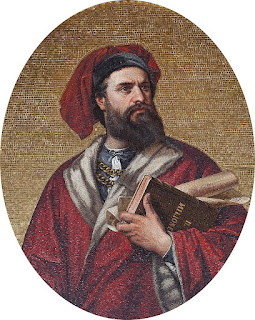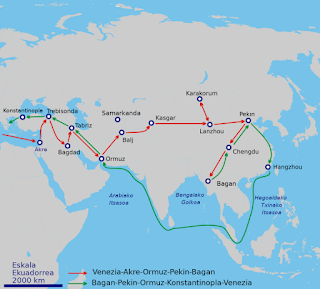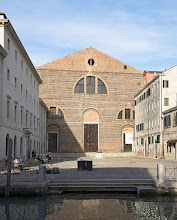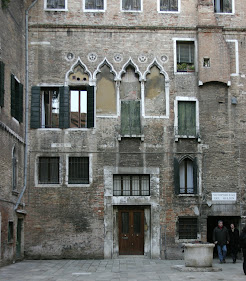NEW - Marco Polo - merchant and explorer
Venetian trader who described travels in China
The Italian explorer Marco Polo, who achieved a place in history as the first European to write in extensive detail about life in China, is thought by many historians to have died on or close to this day in 1324 in his home city of Venice. Accounts of his final days say he had been confined to bed with an illness and that his doctor was concerned on January 8 that he was close to death. Indeed, so worried were those around his bedside that they sent for a local priest to witness his last will and testament, which Polo dictated in the presence of his wife, Donata, and their three daughters, who were appointed executors. The supposition has been that he died on the same evening. The will document was preserved and is kept by the Biblioteca Marciana, the historic public library of Venice just across the Piazzetta San Marco from St Mark’s Basilica. It shows the date of the witnessing of Polo’s testament as January 9, although it should be noted that under Venetian law at the time, the change of date occurred at sunset rather than midnight. Confusingly, the document recorded his death as occurring in June 1324 and the witnessing of the will on January 9, 1323. The consensus among historians, however, is that he probably reached his end in January, 1324. Read more…
_______________________________________
Norberto Bobbio - political philosopher
Intellectual regarded as foremost 20th century commentator
Norberto Bobbio, a philosopher of law and political sciences who came to be seen as one of Italy’s most respected political commentators in the 20th century, died on this day in 2004 in Turin, the city of his birth. He was 94 and had been in hospital suffering from respiratory problems. His funeral was attended by political and cultural leaders including the then-President of Italy, Carlo Azeglio Ciampi. He had been writing essays well into his 90s, despite for much of his life suffering from bouts of what was described as “fatigue and melancholy”. His extensive catalogue of work spanned almost seven decades of Italian political life and societal change from the rise of Fascism in the 1930s to the second premiership of Silvio Berlusconi, of whom he was an outspoken critic. For much of his career, Bobbio was a professor at the University of Turin, where he was chair of philosophy of law from 1948 and, from 1972, of the faculties of legal and political philosophy and political science. He was made a Life Senator in 1984, although he stayed away from playing an active role in Italian politics after failing to gain election to the parliament of the new Republic in 1946. Read more…
____________________________________
Christian burial for the King excommunicated by the Pope
Victor Emmanuel II, the first King of Italy, died on this day in 1878 in Rome. He was buried in a tomb in the Pantheon in Rome and was succeeded by his son, who became Umberto I, King of Italy. Victor Emmanuel II was allowed to be buried in the Pantheon by Pope Pius IX, even though he had previously excommunicated him from the Catholic Church. Before becoming King of Italy, Victor Emmanuel, as King of Sardinia-Piedmont, had secretly encouraged Garibaldi in the conquest of Sicily and Naples. He had then led his Piedmontese army into papal territory to link up with Garibaldi, despite the threat of excommunication. In his quest to become King of a fully united Italy, Victor Emmanuel achieved two notable military triumphs. He managed to acquire the Veneto after linking up with Bismark’s Prussia in a military campaign in 1866. Also, after the withdrawal of the French occupying troops, his soldiers were able to enter Rome through a breach in the walls at Porta Pia and take over the city. This had antagonised Pius IX so much that he refused all overtures from the new King, when he attempted a reconciliation. Read more…
_____________________________________
Massimiliano Fuksas – architect
Brilliant designs illuminate cities worldwide
The international architect Massimiliano Fuksas, whose work has influenced the urban landscape in more than a dozen countries across the globe, was born on this day in 1944 in Rome. The winner of multiple awards, Fuksas sits alongside Antonio Citterio and Renzo Piano as the most important figures in contemporary Italian architectural design. His Fuksas Design company, which has its headquarters in a Renaissance palace near Piazza Navona in Rome, also has offices in Paris and in Shenzhen, China, employing 140 staff. Among more than 600 projects completed by the company in 40 years, those that stand out include Terminal Three at the Shenzhen Bao’an International Airport in China, the New National Archives of France at Pierrefitte sur Seine-Saint Denis, the Peres Peace House in Tel Aviv, the Zenith Music Hall in Strasbourg, the Armani Ginza Tower in Tokyo, the Italian Space Agency headquarters in Rome and the FieraMilano Trade Fair complex on the outskirts of Milan. Ongoing projects include the new EUR Hotel and Conference Centre in Rome and the Duomo metro station in Naples. Read more…
______________________________________
Umberto I – King of Italy
Anarchists made three attempts on monarch’s life
King Umberto I ascended the throne of Italy on this day in 1878. Known by the Italian people as Il Buono (the Good) he succeeded on the death of his father, Victor Emmanuel II. Umberto had already won popular support because of the way he had conducted himself during his military career and as a result of his marriage to Margherita of Savoy and the subsequent birth of their son, who was to become King Victor Emmanuel III. But he was to become increasingly unpopular during his reign because of his imperialist policies and his harsh ways of dealing with civil unrest. Queen Margherita was particularly loved in Naples, where she visited schools and hospitals and organised collections of toys and clothes for the children of poor families. She was seen to hold the hands of cholera victims without wearing gloves and to join the ordinary women in their processions to the Duomo. As a result, Pizza Margherita, with its tomatoes, basil and mozzarella representing the colours of the Italian flag, was created in Naples and named after her. However, her popularity didn’t help Umberto, who was attacked by an anarchist in Naples during the first year of his reign. Read more…
______________________________________
Book of the Day: The Travels of Marco Polo, by Marco Polo, edited by Peter Harris.
Marco Polo set off on his travels from Venice as a young man in 1271, and returned home in 1295 after spending 24 years away, 17 of them in China. He is one of the few early adventurers whose name nearly everyone knows. His book was one of the best-loved works of the Middle Ages, and has remained popular ever since. At a time when China is again assuming global importance, his account of China under the Mongol emperor Khubilai Khan - the dazzlingly splendid capital in Beijing, the great southern metropolis of Hangzhou - is a classic reminder of the antiquity of Chinese power and civilization. His book was often thought of as a book of marvels, but one of its striking features to a contemporary reader is its clarity, realism and tolerance. As this new edition shows, he sometimes exaggerates, but his reputation for making things up is quite unfair, as Colin Thubron makes clear in his introduction. The original manuscript of Marco Polo's book is lost, and in the many later versions names and other details have become so garbled that it has been said that his itineraries are impossible to follow. This new Everyman edition of The Travels of Marco Polo shows this need not be so. It explains clearly all the references in the book, and shows in detail with new maps the routes described from Venice to Beijing, from Beijing to Burma, and from Beijing to south-east China. It also provides an up-to-date history of the book and the controversies surrounding it.Marco Polo was the original, trailblazing tourist. At the age of 17 he embarked on an epic journey to Asia, returning 24 years later to record his extensive travels in a book - publishing possibly the first travel guide ever - introducing Europeans to Central Asia and China. Peter Harris is a writer and translator with a lifelong interest in China and other parts of Asia. Brought up in England, he was a writer and editor for the BBC before becoming a human rights and civil society specialist.


.jpg)

_-_VE_-_Umberto_I_di_Savoia_1%20(2).jpg)






.jpg)








.jpg)
